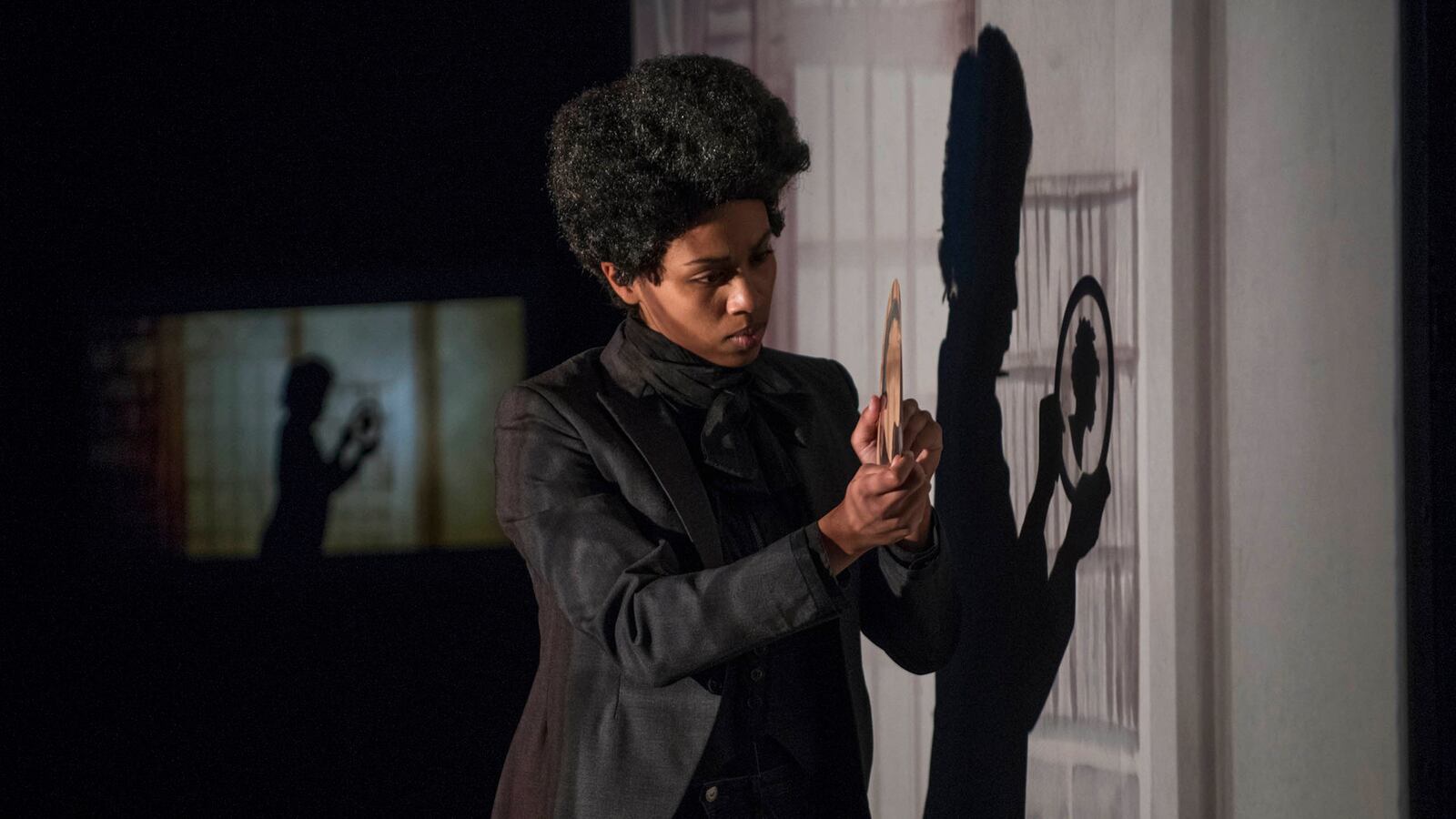Usually on stage, performances have to choose: They can be daring and innovative, or they can land a sucker-punch to the soul. They can be tender and delicate, or they can wow with startling wizardry. They can be rooted in theater’s oldest traditions, with actors alone on a darkened stage before an audience, or they can break the form apart.
Manual Cinema, a five person performance troupe out of Chicago, somehow manages to do all of it at once . For the second time in three years the company is at the Under the Radar festival, the Public Theater’s annual showcase of new and experimental work from around the world, this time to showcase their production of Frankenstein.
It may be a 200-year-old novel, endlessly remade in classic and campy film and television, yet the group breathes new life into the story of the insentient monster.
The aesthetic of a Manual Cinema show would be familiar to any grade-schooler who turned their hand into the snapping jaws of an alligator on the overhead projector in math class. But their puppetry/art/music/theater hybrids layer levels of complexity over the simplest of forms while somehow stripping away all artifice so that audiences can see the work come together in real time.
Two years ago they performed “Lula del Rey,” the story of an adolescent girl living in a trailer in the desert with her nuclear-scientist mother, surrounded by satellites and secrets. She hears some country music on the radio from the fictitious band “The Baden Brothers” and runs away from home, traveling to the big city to catch the group in concert.
It was, like all of Manual Cinema’s productions, told almost entirely through shadow puppets and silhouetted pantomimes projected on a screen, with hardly any dialogue and with an original and live musical score. The effect was like being transported to half-remembered dreams of half-a-century ago, a comic book saga of longing and escape played to a soundtrack that recalled Hank Williams and Patsy Cline.
After the show, audiences were invited to, as they are after every Manual Cinema performance, come on stage and see how the group had put such simple technology to such fantastical uses.
They are keeping the same low-fi, handmade approach with Frankenstein, but pushing it out into the outer reaches of what it can do. There are three screens instead of one.
Real actors are involved, instead of just faces in silhouette (although there remains virtually no dialogue.) It is a story that is spectral and strange. There are so many moving parts that it is hard to know where to look—at the screen? At the actors arranging the puppets on the screen? At the actors getting ready just off stage? But it impossible to look away.
Manual Cinema expanded their approach not because they had tired of what they had done over the past years, but because the story demanded it. Their Frankenstein is a series of stories inside of stories. They nest in one another, much as the novel does.
Yet Manual Cinema adds another element—the story of Mary Shelley herself, overcome with grief on the death of child, confronting the big questions of existence, and trying to be treated seriously by her husband Percy Shelley and his great friend Lord Byron.
“Frankenstein does feel a bit like the accumulation of everything we have learned over the past eight years. It’s pulling out all the stops to make something crazy complicated,” said Kyle Vegter, a composer and one of the group’s artistic directors. “Frankenstein is the perfect story for us, because it is about animating something that is lifeless. We are drawn to work that is dark, that has a certain noir quality to it.”
All five of the artistic directors of Manual Cinema met in Chicago, where they all in the city’s theater and music scenes. Julia Miller was a director and performer and was asked to design shadow puppetry for a Chicago symphony performance of Swan Lake.
She realized that the work, “combined a lot of things I was excited about--illustration, animation, film, nonverbal storytelling. It was awesome, and it was something I wanted to try out for myself.”
Her landlord was a medical lecturer, and kept an overhead projector in the garage. She “borrowed” it (“I don’t think he misses it,” Miller said. “I still have it.”) She hooked up with two other veterans of the city’s theater scene to produce an early version of “Lula del Rey,” and asked Vegter, who had moved to Chicago after graduation from college in Florida to pursue a career in music, if they could use some songs they had heard his band perform. Vegter suggested instead that he and a bandmate write original music, and Manual Cinema was born.
They started playing bars and lofts of Chicago, taking the simplest of mediums and seeing what they could wrestle out of it. They wrote all of their own stories and songs, designed their own sets, and wherever they performed audiences wanted more.
Two members had a ground floor apartment with large bay windows in front, and so they performed their first full-length work, Ada/Ava, the gothic New England story of a septuagenarian woman plotting through the space between life and death after the death of her twin sister, for audiences gathered on the sidewalk on Halloween, with the speakers set up nearby in the bushes.
“When you tell a story without words, it becomes accessible to more people, and you have to think about things in a more global way,” said Miller. “It is more exciting. You are working with gesture and action and archetype.”
The last couple of years have seen Manual Cinema burst out of the confines of the Chicago loft scene, and it seems unlikely that they will remain under the radar for much longer.
Chris Jones, the theater critic for the Chicago Tribune, named the group last month “Chicagoans of the Year,” and they have been performing over the last couple of years not only in Boston, Brooklyn and Berkeley but Saudi Arabia, Egypt and across Europe.
“From the inside it doesn’t feel that different,” said Vegter. “All five artistic directors love to work and work a ton. We have basically been hustling for years from the inside. For us, it is about working really hard, building the infrastructure, and learning all the time about what this medium can do.”
The key to the medium, they say, is fidelity to storytelling. The art and music comes later, after landing on something that takes audiences on some kind of emotional journey.
“Everything comes back to the story for us,” Vegter said. “We don’t set up to find what’s the biggest, craziest thing we can come up with. We ask ourselves what do we need to tell a story effectively.”
In performances with so many moving, often hand-built parts, each show is a bit of a high-wire act. Something is bound to go wrong, no matter how much they rehearse. At one show recently, the bulb of an overhead projector went out, leaving a portion of the performance in darkness. The show went on, as it always must, until a replacement bulb could be found.
But in a world that is increasingly dominated by screens, in which the mechanics of production are hidden from viewers, Manual Cinema sets to tap into a desire people have for something different, something simple and homespun, that any one could do if they had a tinkerer’s thumb and a couple of interested sidekicks.
“The idea is that people become inspired with making stuff,” said Vegter. “They can come up on stage afterwards and see what we’ve done and walk away thinking they could do it too.”
Manual Cinema's Frankenstein is at the Public Theater, NYC, Jan 7, 10, 11, and 12.







